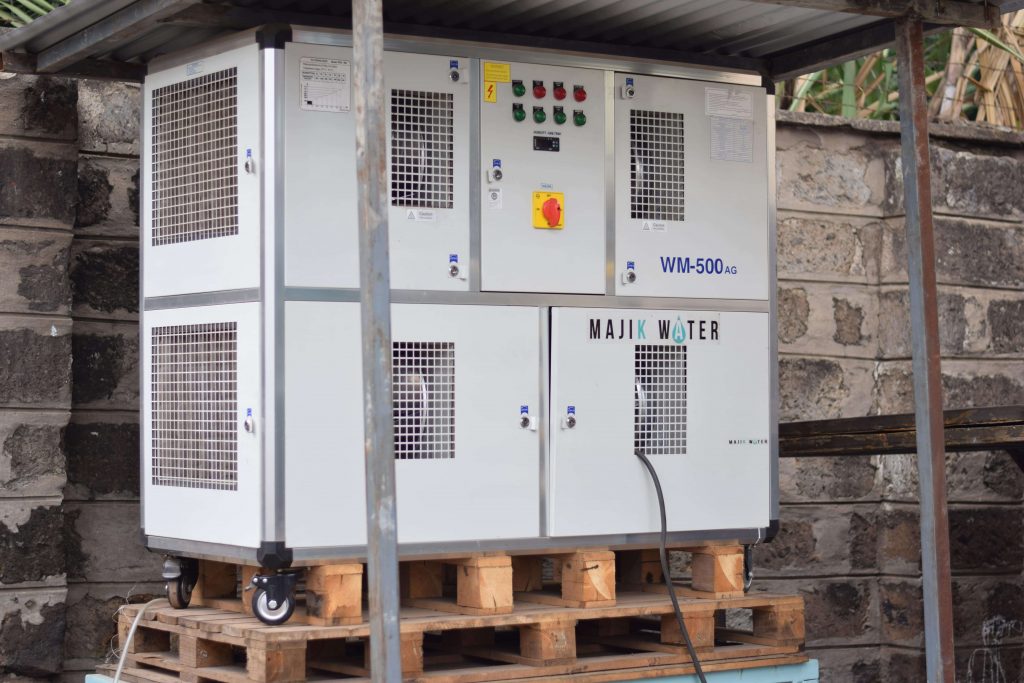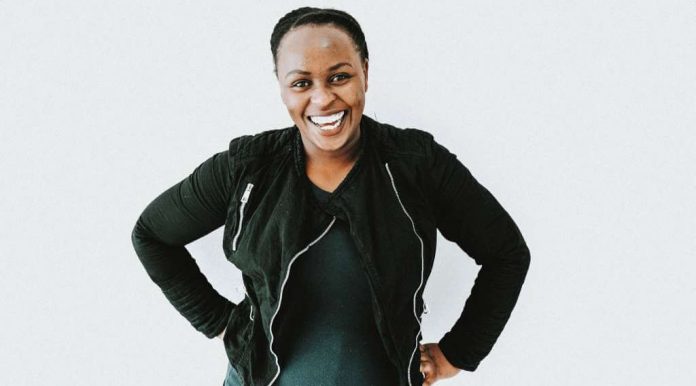Beth Koigi is on a mission to have every Kenyan gain access to clean drinking water forever by simply turning air around them into water. If you think it sounds like magic, well, that’s exactly how the name of her company sounds.
Koigi, aged 28, is the CEO and co-founder of Majik Water – a social enterprise using science and technology to solve water shortages in the region. The aim is to democratise access to the basic commodity by squeezing out clean droplets from the most abundant resource, air.

“Basically we’re getting water from the atmosphere using our electric devices; in other words, harvesting water vapour in the air. And there are many ways you can get water from the air. For instance, you can harvest dew, you can harvest fog and mist, and you can harvest the humidity itself – an option we’re doing,” Koigi said in an interview at her premises in Industrial Area, on the bustling outskirts of the capital Nairobi.
She reveals that humidity harvests, which the company has opted for, are suited for regions with little or no dew and mist, mostly arid and semi-arid areas with solar powering the kits.
To be clear, turning air into ready-to-drink water may sound a bit like magic but the company’s name – Majik – also denotes something else. It comes from combining Swahili word for water ‘maji’, with the first letter of the word for harvest ‘kuvuna’, because that’s exactly what Majik Water does – they harvest water.
The company roots can be traced back to 2017 when Koigi participated in a global programme at Nasa Research Center in Carlifonia where social entrepreneurs gather annually to explore ways to tackle world’s challenges.
While there, she met Anastasia Kaschenko, an American environmental scientist, and Clare Sewell, a British economist. That’s how the three women brainstormed the idea and Majik happened.
“The three of us were connected by the need to see a world where everyone has access to adequate and clean drinking water and prevent spread of waterborne diseases,” said Koigi, a project manager by profession.
Prior, she had another water-related enterprise which folded in 2016 after five years of operation. Until closure, her venture which she started while still in college dealt in water filtration – making and distributing low-cost tap water filters targeting urban households. Tap water in major towns across Kenya is sourced from dams and piped to homes. It somehow gets contaminated along the way, making it unsafe for drinking raw, an opportunity Koigi had previously spotted.
Besides households, she sold the water filters among students to purify the dirty tap water in college dormitories as a cheaper alternative to purified bottled water.
Then Kenyan towns were hit by water scarcity in 2016 as a result of drought, cutting off tap water supply and her filter sales plunged and disappeared, never to recover.
“People were no longer investing in water filters as there was no tap water to be filtered. That’s how I started looking at the water issue as a scarcity issue rather than a pollution issue, basically a change of business model,” said Koigi.
With dry taps and erratic supply, people turned to bottled water dispensers to slake their thirsts while refilling their jerricans at the neighbourhood water points for other uses.
One door had closed, only for the other to open with her visit to California.
“That incident prompted me to look at how we can democratise water sources. People don’t have to be limited to tap water or any single source to have access to basic drinking water, especially so in arid and semi-arid areas,” she said. That would form the value proposition for her new enterprise.
The startup has so far sold eight water harvesting machines, largely in Kenya’s dry, marginalised locations.
The company can make devices that can harvest as much as 100,000 litres of water from air per day, depending on client needs.
“Initially we targeted individual households in arid areas, then we found out they didn’t have the capability to pay for it even if they buy per litre through water ATMs,” said Koigi.
This, she said, prompted a strategy shift to wholesale model to enable the company to cover its overhead and operational costs in the meantime. Seeking to democratise water access, the enterprise is now exploring options to return to serve both institutions and households, including pay-as-you-go model where homes would be paying small amounts daily on their phone for use of the water kits.
“Right now we’re working with NGOs (non-governmental organisations) who are working in such arid regions and have water projects,” said Koigi.
“We’re also working with corporates who are doing CSR (corporate social responsibility) or who want to reduce their water footprint. For example companies that use a lot of water and want to reduce their dependence on on-the-grid water sources,” she added.
Its flagship device processing 500 litres per day costs about $15,000 (Sh1.5 million) and can be powered by either electricity from the national grid, solar power or generator.
“We envision the costs going down in coming years as the technology advances and more people get aware of it, enabling us to scale,” she says adding that her focus is on creating awareness campaigns of the kits as an alternative water source and pushing the costs down.
Would she consider selling water directly besides the machines?
“That’s not our market, we don’t sell water. We just sell the machines,” she says, emphasizing the firm is focusing on where it has comparative advantage.
The startup is currently doing humidity harvests, suited for dry areas, using condensation method.
For harvesting humidity, there are two ways of going about it, Koigi says.
“The first is condensation while the other is by using special materials with high affinity for water molecules, so basically they absorb water vapour in the air and when you heat the materials they release the water,” she explained.
Her machines use condensation model.
Considering air pollution in the atmosphere, what guarantees do customers have that the extracted water is not contaminated? we seek to find out.
Koigi is quick to point out that the method in use prevents such an eventuality from happening.
“Air pollution doesn’t affect the quality of water we collect. Granted, contamination may happen from rusting of the device or dust, but at the end of the whole process we have added filtration system to make sure the water is safe for drinking,” she said.
“We collect distilled water and we also have a mineralisation chamber to make the water better for drinking,” she added.
Read also: Vlogger Giving A Voice To Green Enterprises
How it works.
The device comprises of four components which are identical. The components have an air inlet, condensation chamber, a fan, air outlet, compressor, refrigerant gas, collection tray and a pipe.
By use of fans, air is sucked into the condensation chamber through an inlet followed by expulsion of hot air.
“We use a similar compressor-refrigerant kind of system, very similar to a fridge. So we have the compressor and the refrigerant gas. So the refrigerant gas is used for condensation,” she says.
“After condensation water is collected on a tray then the hot air is blown out by the fan. The collected water is then transported through a pipe to an external collection tank.”
Challenges
“Like any new technology, convincing people takes time. Also financing hasn’t been easy; we’re self-funded up to this point,” she says.
“We want to reduce the overall costs of these devices in such a way that anyone can afford them. And also make people become aware that this is a water source that people can actually consider as an alternative to boreholes, for instance,” she signs off.
There’s an estimated six times more water in the atmosphere than in all rivers combined. By tapping this untouched resource, the most affected parts of the world can have abundant, clean water.
Their game-changing invention hasn’t gone unrecognised. Majik Water won Africa’s first EDF Pulse Awards and emerged finalists for 2018’s UN Environment’s Young Champions of the Earth.



